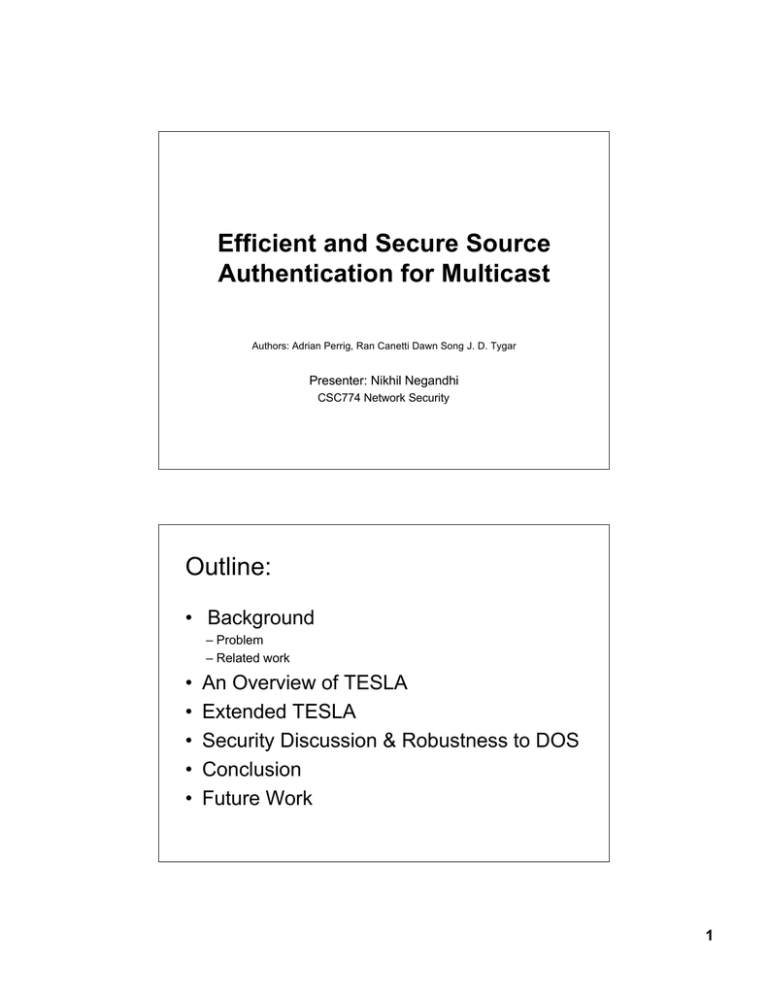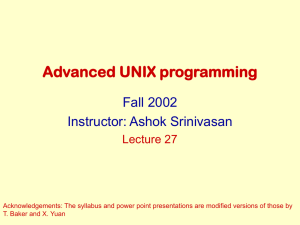Efficient and Secure Source Authentication for Multicast Outline:
advertisement

Efficient and Secure Source
Authentication for Multicast
Authors: Adrian Perrig, Ran Canetti Dawn Song J. D. Tygar
Presenter: Nikhil Negandhi
CSC774 Network Security
Outline:
• Background
– Problem
– Related work
•
•
•
•
•
An Overview of TESLA
Extended TESLA
Security Discussion & Robustness to DOS
Conclusion
Future Work
1
Problem: Efficient Source Authentication
• One sender, many receivers
• Receivers not trusted
• Lossy channel (lost packets are not
retransmitted)
Related Work:
• Digital Signatures
Advantage: Non-repudiation
Disadvantages: Too expensive, DOS on the receiver
• Simple MAC using shared secret as in
UNICAST
Advantages: Low overhead , MAC computation is fast
Disadvantage: Insecure in multi-party case
2
An Overview of TESLA
• Provides multicast source authentication
• Efficient:
- symmetric-key cryptography
- 1 MAC function computation (1,000,000/s)
- Low overhead per packet (10-20 bytes)
• Perfect loss robustness
• Scalable: After initial receiver bootstrap,
unidirectional data flow
• Drawback: Delayed authentication
TESLA: The basic idea
3
Security Condition
• A packet arrived safely if the receiver is assured
that the sender cannot yet be in the time interval
in which the corresponding key is disclosed.
• Receiver verifies that packet P arrives before
sender discloses KP
• If security condition not satisfied, drop the packet
Sender Setup
•
Interval definition
- Beginning time of one specific interval
- Interval duration, disclosure delay
• Key chain
- Compute using a pseudo-random function F
- Digitally sign K0, give to receivers at registration.
4
Sending/Receiving
Authenticated Packets
• Packet Pj sent in interval Ii is: {Mj/MACki(Mj)/Ki-d}
• The key remains secret for _____ future intervals
• Packets sent in interval Ij can disclose key
_________
Drawbacks of TESLA:
• Receiver has to buffer packets
- DoS attacks on the receiver
• Overhead for receivers in heterogeneous networks
- uses many keys with different disclosure delays
• Synchronization
- costly due to public key operations
• Not-scalable
- sender has synchronized with all the receivers before
transmission starts.
5
Extended TESLA:
•
•
•
•
Immediate Authentication
Concurrent TESLA instances
Time Synchronization
Determining Key Disclosure Delay
Immediate Authentication
• Receiver authenticates packets as soon as they arrive
• Sender buffers packets during one disclosure delay
• Sender stores hash value of data of later packet in an earlier
packet
If packets are dropped, authentication ?
6
Concurrent TESLA instances
Why require multiple instances of TESLA with different disclosure delays?
- low delay receivers :short key disclosure delay
- high delay receivers: long key disclosure
Solution:
Same key chain but a different key schedule for all instances
Kui+du = MAC key in Ii‡disclosed in Ii+du
Concurrent TESLA instances
Advantages
• Generates all different independent keys
for each instance
• Sender needs to disclose one key chain
independent of number of concurrent
instances
7
Time Synchronization
•
•
Loose time synchronization
Receiver knows an upper bound of difference between sender’s local time and
the receiver’s local time = (del)
1.
•
•
•
Direct:
Explicit time synchronization with sender
No extra infrastructure needed
Two-phase protocol
•
•
Del=ts-tr
DoS ?
2.
•
•
Indirect
Implicit Time Synchronization
Synchronize with a time reference
Determining Key Disclosure Delay
• Short disclosure delay‡ security condition
violated‡ packets
drop
• Long disclosure delay‡ long authentication delay
• Security Condition is
[(tRi + del –To)/Tint] – Ij < d
d = disclosure delay in time intervals
Tint = interval duration
To = beginning time of 0th time interval
tRi =receiver’s local time when packet Pi arrives
Ij = time at which packet Pi is constructed
del = upper bound of difference between sender’s local time and the
receiver’s local time
[ ] = truncate function
8
Security Discussion and
Robustness to DoS
DoS Attack on the Sender
•
•
Not possible with indirect time synchronization
Possible with direct time synchronization
Solution:
•
•
•
•
•
Sender aggregates multiple requests
computes and signs a Merkle hash tree that is generated from all the
requester’s nonces
Root Had is included in signed part instead of receiver’s nonce
To verify the signature, each receiver reconstructs hash tree
Example:
•
A will receive Nb , Hcd
No. of nodes returned = _____________
Security Discussion and
Robustness to DoS
DoS Attack on the RECEIVER
• Replay Attack
- security condition drops packets if replayed with a long delay
- add sequence number to each packet
• Flooding with bogus traffic
- security condition drops a packet after one disclosure delay
•
- immediate authentication
Attacker fools receiver to believe that packet was sent out far in the future
- in order to verify the disclosed key the receiver would hash until last
committed key chain value
- foiled by checking packet interval <= latest interval sender can be in
Ij <= [(ti-To)/Tint]
9
Conclusion
• Basic TESLA provides low computation and communication
overhead and perfect lost robustness
• Additional information in a packet used to provide immediate
authentication
• Reduced overhead when multiple TESLA instances are concurrently
used with different authentication delays
• Derived a tight lower bound on disclosure delay
• Hardened the sender and receiver against various DoS attacks
FUTURE WORK
• Source authentication with nonrepudiation
• Perfect time synchronization techniques
with less complexity and low overhead
10





